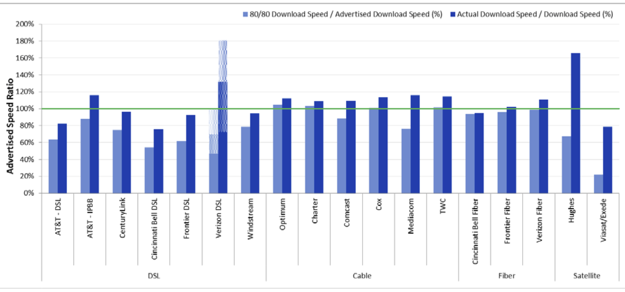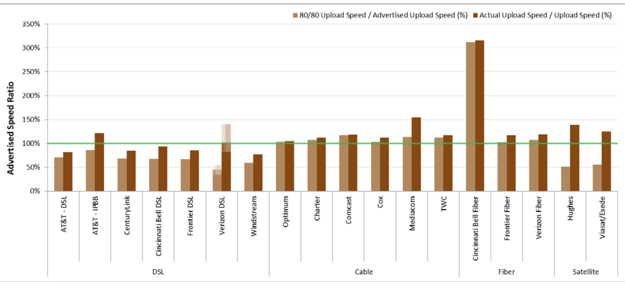
The FCC’s primary broadband metric is now the 80/80 benchmark: the minimum speed that 80% of users experience, 80% of the time during primetime viewing hours. When evaluated against that benchmark, cable modem and fiber-to-the-home systems do a reasonably good job of delivering service at advertised speeds. Among Californian providers, only Comcast fell noticeably short, with actual download speeds hitting around 90% of what they promise.
Telco DSL-based service doesn’t do so well. According to the FCC’s latest field tests, AT&T’s and Frontier Communications’ legacy DSL services – the kind you often find in rural California – deliver speeds that are about 60% of what they promise. AT&T’s advanced DSL systems – the upgraded kind that go into high potential neighborhoods – score around 90%.
On the upload side, cable and fiber providers generally meet or exceed their promised speed levels, but telco copper systems do even worse, again with the exception of AT&T’s upgraded systems.

People use Internet service differently now than they did seven years ago, so the Federal Communications Commission added consistency metrics to its annual report on broadband performance in the U.S. It’s an acknowledgement that a steady stream of data, to support online video viewing, is more important than the occasional bursts of speed that old school web browsing requires…
We found that for most ISPs, actual speeds experienced by subscribers nearly meet or exceed advertised service tier speeds. However, since we started our MBA program, consumers have changed their Internet usage habits. In 2011, consumers mainly browsed the web and downloaded files; thus, we reported average speeds since they were likely to closely mirror user satisfaction. By contrast, by September 2016, the measurement period for this report, many consumers streamed video for entertainment and education. Both the median measured speed and how consistently the service performs are likely to influence the perception and usefulness of Internet access service.
The FCC bundled all of its telecoms and media research – wireline and mobile broadband, and video – into one giant data dump. The report includes a well-deserved shout out to the CalSpeed mobile broadband speed testing program. It’s run by the California Public Utilities Commission and even the FCC considers it a valuable and independent source of information about what mobile carriers (and, soon, wireline ISPs) actually deliver.
Much of the data was held back by the FCC for up to two years. John Brodkin has a good write up on that problem in Ars Technica. Ajit Pai won’t explain why this is the first time the broadband speed and availability analysis was released since he became FCC chair.
In some ways, Pai is remarkably open about FCC deliberations compared to his predecessors. He routinely releases draft decisions three weeks before commissioners vote. In the past, drafts were kept out of the public eye, although lobbyists with sufficiently deep pockets always seemed to know what was coming. But Pai is also cagey about what he releases, holding back this latest round of broadband data, as well as details regarding the millions of apparently bogus emails uploaded to FCC servers during the net neutrality debate.
Commissioners are scheduled to formally adopt the findings at their meeting on Wednesday.
FCC Communications Marketplace Report Collected Appendices, 4 December 2018 (this is the big document with the interesting data)
FCC draft Communications Marketplace Report, 21 November 2018
